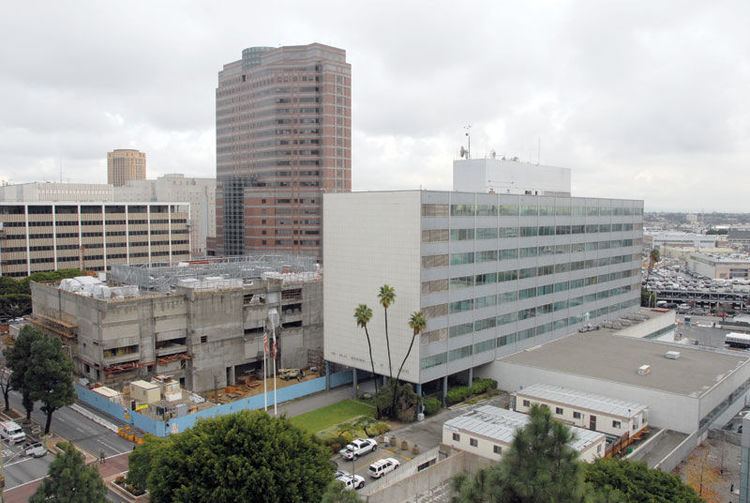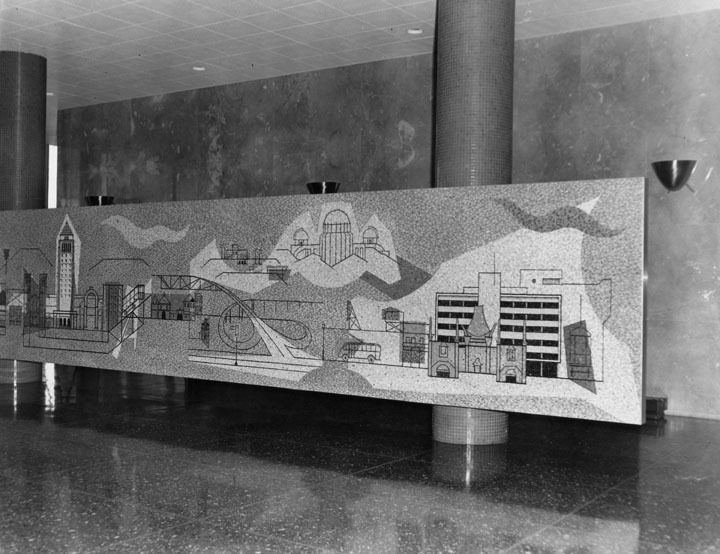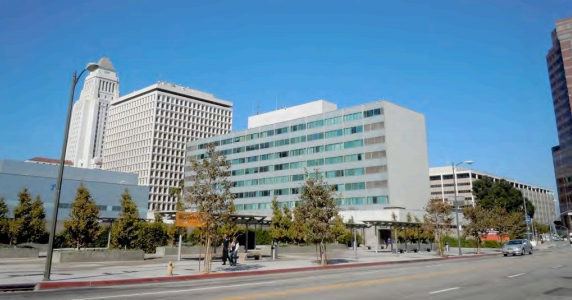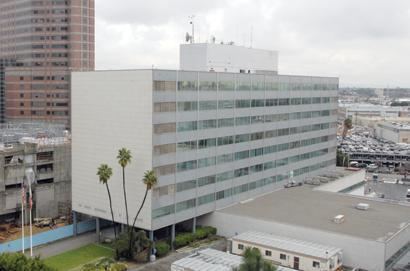 | ||
Similar Los Angeles City Hall, Metropolitan Detention Center - L, Men's Central Jail, Cathedral of Our Lady of the An, Capitol Records Building | ||
1992 los angeles riot start at the parker center
Parker Center was the headquarters for the Los Angeles Police Department from 1954 until October 2009 and is located in downtown LA. Often called "The Glass House", the building was named for former LAPD chief William H. Parker. Originally called the Police Administration Building (PAB) (or Police Facilities Building), groundbreaking for the center began on December 30, 1952, and construction was completed in 1955. The architect was Welton Becket. The building combined police facilities that had been located throughout the Civic Center area. The location was previously home to the Olympic Hotel.
Contents
- 1992 los angeles riot start at the parker center
- Lapd parker center exteriors
- New headquarters
- 2015 efforts to save Parker Center
- Recent developments
- In entertainment
- References
On July 16, 1966, Chief Parker had a fatal heart attack. Soon afterward, the Los Angeles City Council renamed the building "Parker Center". The building was one of the sites of unrest during the 1992 Los Angeles riots following a not-guilty verdict for the four police officers in the Rodney King matter.

Lapd parker center exteriors
New headquarters

With time, the Parker Center became outdated and was in need of expensive seismic retrofits. After considering a number of downtown sites for a new facility, the city council selected a property directly south of City Hall, Caltrans' former Los Angeles headquarters. Ground was broken for the new building in January 2007, which was dedicated on October 24, 2009.

Both the Old Parker Center and the new headquarters have heliports. The Old Parker Center heliport is marked with a number "5", while the new center is inscribed with an "H".
The LAPD Robbery and Homicide Division still operated from an annex of the Old Parker Center.

On January 15, 2013, the City of Los Angeles permanently closed Parker Center. In 2014 the City Department of Public Works and the Bureau of Engineering recommended razing the now vacant Parker Center in favor of building a 27-story tower in its place. The razing would proceed on a floor-by-floor process, eliminating the need for wrecking balls or dynamiting. Construction of the new building would start in 2016 and last 18–24 months, with completion anticipated in 2018.
2015 efforts to save Parker Center

On January 29, 2015, a city panel, The Cultural Heritage Commission, nominated Parker Center for historical status. The final decision rests with the city council, which has three months to consider it. A tentative date for the ruling was set for April 28, 2015. However, the ruling was postponed until May 5, 2015. The deadline for the City Council to grant Parker Center landmark status expires on May 13, 2015. If a decision is not made by that date, the nomination fails. During the council meeting held on May 5, 2015, the council claimed to have "lost jurisdiction over this item" due to a technical error and did not act in time (within a 105-day time limit). Committee chairman and 14th District Councilman José Huizar thus reminded the council of the May 13th deadline and stated his forthcoming intention to nominate Parker Center as a historical landmark. This presupposes that someone unilaterally seeks to reapply for nomination, which Huizar encouraged the Cultural Heritage Commission and Department of City Planning to do. He also presented a new motion, recommending against the razing of the building, instead preserving it and "build[ing] an adjacent tower taller than the one analyzed in the project's already complete environmental impact report". The city's Office of Historic Resources will submit another nomination for the Parker Center and officials will review it and proceed with the matter from there. The case was issued case number "15-0127". Following these developments, a group of civic leaders and land-use experts convened in May 2015 to discuss the future of Parker Center. They considered whether the former City of LA police headquarters should be preserved, and came to a consensus that Los Angeles’ 1997 Civic Center Master Plan requires updating, with some of the panel members suggesting that parts of the Parker Center could be preserved while other sections could be razed. In August 2015, it was reported that the discussions regarding the Parker Center had expanded and now revolved not just the future of the building itself, but also what should be done with surrounding areas and the district on a whole. This suggested the possibility of an alternative location for the proposed office space buildings intended to be erected on the plot currently inhabited by the Parker Center. As of September 2015, three options were considered for the Parker Center.

- Updating the 319,000-square-foot edifice with improvements including seismic retrofitting and expanding the parking garage to provide another 137 spaces.
- Rehabbing some of the building while tearing down the dilapidated Parker Center jail while creating more than 522,000 square feet of usable space.
- Razing the building and replacing it with either one or two office structures with a total of about 750,000 square feet of space and 1,173 parking spaces.
Recent developments
In August 2016, the Parker Center building was threatened by demolition once again. A report from the Bureau of Engineering revealed a proposal to build a new municipal office building on the existing site of Parker Center. Given the threat of demolition, the Cultural Heritage Commission quickly mobilized another attempt the following month to award the Parker Center with a landmark status, after having failed to meet the deadline to do so during the preceding year. While the city reviews the building’s nomination for landmark status, the Bureau of Engineering's proposed demolition project will also be reviewed by Public Works and Budget and Finance committees. Los Angeles Conservancy expects those committees to provide their respective recommendations by early 2017.
However, in December 2016 the city Bureau of Engineering once again recommended razing the building, saying that tearing down the structure and creating the new high-rise would cost $514 million. The city Bureau of Engineering claimed that the preservation and smaller new edifice option would cost $621 million (both plans would have roughly the same amount of office space). The city Bureau of Engineering's timetable suggested securing approvals by February 2017.
In entertainment
Parker Center appears in many episodes of the television drama Dragnet, beginning with the fifth season in 1955. It also appears in several establishing shots for the Perry Mason TV series between 1958 and 1966. It appeared in at several episodes (seasons 3, 4 & 10) of Columbo. The popular NBC drama Hunter also used the Parker Center in the sixth and seventh seasons. Parker Center is also the location of the Priority Homicide Division, and later, Major Crimes on the television series The Closer.
The building is also featured as one of the main locations in Police Quest: Open Season, the fourth installment of the Police Quest series, a 1993 PC video game by Sierra Entertainment.
Parker Center was also featured in the 1970-set 2014 film Inherent Vice.
Parker Center is often mentioned in the novels of the Harry Bosch series written by Michael Connelly and the Shane Scully series written by Stephen J. Cannell. Parker Center and its closure is also mentioned in the Joseph Wambaugh novel Hollywood Hills.
Perhaps the most popular, and most filmed/photographed, example is the 1983 movie Blue Thunder.
